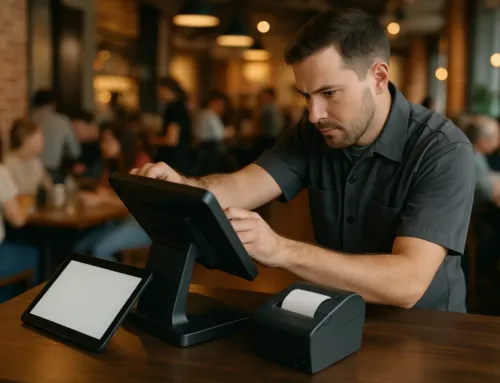Have Questions? Let’s Talk!
It’s Not Just an Inconvenience – It’s a Revenue Risk
When your POS system goes down, your business doesn’t just hit pause, it starts bleeding money.
Even a brief outage during lunch rush or peak retail hours can create long lines, lost sales, and frustrated customers. But the real cost of POS downtime goes beyond immediate transactions. It affects your team’s productivity, damages your brand reputation, and forces you into manual workarounds that create chaos long after the systems are back online.
The worst part? Most businesses don’t realize how costly these interruptions are until they’ve experienced one.
In this post, we’ll break down the true cost of POS downtime, the most common causes, and most importantly, how you can prevent outages before they disrupt your day and damage your bottom line.
The Real-World Costs of POS Downtime
POS system failures don’t just slow you down, they chip away at your revenue, reputation, and operations in ways that are often underestimated. Whether it’s a 5-minute glitch or a full-blown crash during peak hours, the impact is real and measurable.
1. Lost Revenue
Every minute your system is down means missed sales. For high-volume operations like restaurants, cafés, or retail stores, those lost transactions can quickly add up, especially during lunch rushes, weekend peaks, or events.
And those customers? They may not wait.
2. Damaged Customer Experience
Nothing frustrates a customer faster than waiting in line for a system reboot or being told you can’t take card payments.
Long waits, unclear processes, or being handed a receipt to “come back later” can leave a bad impression – one that often leads to lost loyalty or negative reviews.
3. Productivity Loss
When your team is forced into workarounds, manually writing down orders, calculating change, or logging transactions by hand, it disrupts everything. Not only are you less efficient, but you also increase the risk of mistakes and reporting errors.
4. Costly Recovery Time
POS downtime doesn’t end when the system comes back online. You’ll still need to:
- Manually re-enter missed sales if your POS doesn’t have an offline mode
- Reconcile inventory that wasn’t tracked in real time
- Verify tips, discounts, and tax totals that may be incorrect or incomplete
That means more time spent fixing the problem and less time focused on running your business.
These aren’t “tech issues” – they’re business risks. And most of them are preventable.
Common Causes of POS Downtime
POS systems are at the heart of your operations, but they’re also vulnerable to a range of technical hiccups that can bring business to a halt. The good news? Most of these issues are preventable once you know what to look for.
1. Hardware Failures
Terminals freeze. Receipt printers stop responding. Payment readers disconnect.
Over time, heavily used POS hardware can wear down or malfunction, especially if it’s not built for high-volume environments.
2. Network Issues
If your internet goes down, so does your ability to process payments, sync sales data, or communicate with cloud-based systems.
Poor Wi-Fi coverage, unstable service, or lack of redundancy are leading causes of POS outages.
3. Power Interruptions
Power surges, outages, or even accidentally unplugged terminals can cause full system crashes.
Without backup power, your POS may take minutes – or hours – to recover.
4. Outdated Software
Old POS software or firmware can be buggy, incompatible with new hardware, or vulnerable to security issues. Skipping updates or patches is a fast track to instability.
5. Lack of Monitoring and Maintenance
Many businesses only realize something is wrong after the system crashes. Without real-time monitoring or proactive health checks, you’re stuck reacting instead of preventing.
These issues aren’t rare, they’re common. But with the right tools and support, they’re also avoidable.
How to Prevent POS Downtime Before It Happens
The best time to solve a POS problem is before it starts.
While you can’t eliminate every possible risk, there are proven ways to dramatically reduce downtime, and keep your operations running smoothly, even when something goes wrong.
1. Use Business-Grade, Monitored Hardware
Consumer tablets or budget terminals may work short-term, but they’re not built for constant use.
Invest in durable, commercial-grade devices designed for your industry, and ensure they’re being monitored for health and performance.
2. Keep Systems Updated
Updates aren’t just about new features, they fix bugs and security flaws that can crash your system.
- Regularly update your POS software, apps, and connected devices
- Schedule updates during off-hours to avoid service disruption
- Use automated patching when available
3. Strengthen Your Network Setup
- Place routers and access points strategically to eliminate signal dead zones
- Use a dedicated Wi-Fi network or VLAN just for your POS
- Implement LTE or fiber backup to stay online even if your primary internet fails
4. Add Power Backup
Install uninterruptible power supplies (UPS) for all critical POS terminals.
Even a brief power dip can cause systems to reboot, costing you time and sales.
5. Work with a Proactive POS Support Provider
This is the real game changer. A managed support partner like SORA Partners can:
You don’t have to live with the fear of POS failure.
With the right setup and support, downtime becomes rare, and recoveries become fast and painless.
Stay One Step Ahead of Downtime
POS downtime isn’t just a technical hiccup, it’s a business disruption. Every minute you’re offline costs you money, trust, and momentum.
But here’s the good news: most of it is avoidable.
With the right hardware, a solid network setup, and proactive monitoring in place, you can minimize the risk of outages—and respond faster when something does go wrong.
At SORA Partners, we help businesses stay one step ahead of POS problems with real-time system monitoring, remote troubleshooting, and ongoing support designed to keep your operations running at full speed.
Because in your business, every transaction counts.
Want to prevent POS downtime before it costs you? Let’s talk.
Let’s Elevate Your Business Together
We’re here to help you navigate the latest trends, adopt innovative solutions, and tackle your biggest challenges. Whether you’re exploring POS systems, managed IT services, or website design, our experts are ready to provide tailored guidance for your business.
Fill out the form below to schedule your free consultation. Let’s create a solution that works for you.


